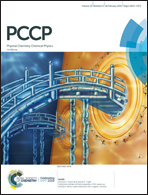A balancing act of two electrons on a symmetric double-well barrier in a high frequency oscillating field
Abstract
The dynamics of two electrons in a three-dimensional symmetric double-well quantum system is controlled using a high frequency oscillating electric field, achieving pairing of electrons and barrier-top localization. The field parameters of oscillating electric field intensity and frequency which are required to induce such an effect of barrier-top stabilization are easily estimated using time-independent Kramers–Henneberger electronic structure Full Configuration Interaction (FCI) calculations in an oscillating frame of reference with a Gaussian basis set. In the presence of the laser, the energy of the two-electron system in the symmetric double-well is found to be minimized when the barrier-top dynamic stabilization happens. Furthermore, the barrier-stabilized state finds importance in achieving a temporal control over electronic ionization. From approximate time-dependent calculations in the laboratory frame, the signatures of the barrier stabilized state are realized and it is observed that the paired-up state remains stable as long as the continuous wave region of the laser pulse is on. Ionization happens as soon as the laser pulse is switched off, because of the increased electronic repulsion in the paired up barrier-top state, thus giving a temporal control over laser-induced ionization.



 Please wait while we load your content...
Please wait while we load your content...